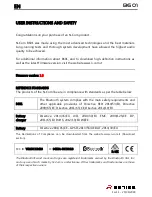
11
Section 4: FAQ
Q1: What are the characteristics of the silicone chamber?
A1: The strain chamber is made from silicone elastomer consisting of polydiethylsiloxane as its
major component. The chamber surface is strongly hydrophobic and cells have difficulty attaching
to it; therefore, the chamber surface should be coated with an extra-cellular matrix like fibronectin,
collagen, laminin, or gelatin before cultivation.
Q2: Cell attachment on the stretch chamber is not consistent.
A2: There may be wrinkles or bubbles on the bottom surface of the strain chamber when seeding
cells. Although the chamber is carefully made not to have wrinkles on it, some products might
have little wrinkles due to its thin structure. We recommend the following steps. Place a small
volume of ethanol in a Petri dish that is large enough to hold the strain chamber. Gently place the
chamber in the culture dish starting at one edge and moving toward the opposite edge of the
chamber to remove air bubbles between the dish and chamber. Allow the ethanol to evaporate
before spreading your cell suspension in the chamber.
Q3. Cell attachment on the stretch chamber was confirmed by microscopy. But the cells detached
from the chamber surface after stretching the cells.
A3: Try seeding your chambers at a lower concentration of cells. Over-confluent cells generally
adhere to neighboring cells rather than to the base matrix (dish surface). When an excess amount
of cells are put in a culture dish, the cells connect to each other after growth. Such behavior of the
over-confluent cells, which are often observed in normal culture dishes, is even worse in the strain
chamber.
A second possibility for cell detachment is that the cells were damaged by enzyme treatment such
as trypsin before seeding. The damaged cells sometime attach to surfaces by non-specific binding
and are not specifically bound to the extra-cellular matrix coating on the chamber; therefore, time,
concentration, and temperature for the enzyme treatment should be optimized to reduce cell
damage.
A third possibility is insufficient coating of the chamber preventing the cells from attaching to the
chamber. Longer coating time is recommended. Some researchers coated the chamber with two
or more kinds of the extra-cellular matrix materials to increase binding effectiveness.




































